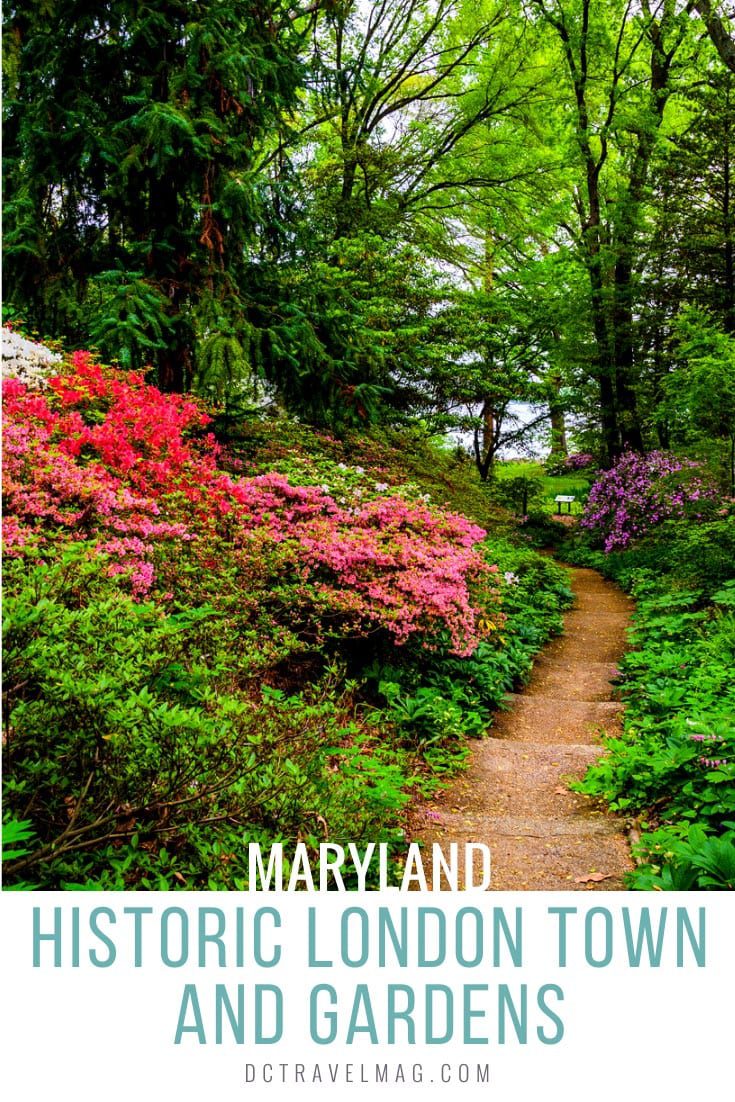There are loads of things to do in Washington, D.C., but when you escape the city, you will find the story of the nation spans across state borders, into Maryland and Virginia. In our effort to highlight all of the best historic sites and gardens in the Washington, D.C area, we spoke with Lauren Silberman, Deputy Director at the Historic London Town and Gardens to share what makes this park featuring history, archaeology and horticulture so special. We are also diving into why you should visit and what you need to know before you go to this twenty-three acre park on the South River in Edgewater, MD.

Where is Historic London Town and Gardens located?
Location: 839 Londontown Road, Edgewater, MD 21037 (on the South River, just outside Annapolis)
Historic London Town and Gardens is owned by, but run by the London Town Foundation, a non-profit organization.
What topics does this historic site cover?
Historic London Town and Gardens covers two main topics: colonial history and gardens.
London Town was a colonial port town founded in 1683 on the South River (now found along the river in Edgewater, Maryland). The town thrived for about 100 years before becoming a “lost” town. The site remains because one of the original buildings (a gorgeous Georgian-style tavern called the William Brown House, c.1760) became Anne Arundel County’s almshouse for people who were poor or had nowhere else to go.
After the site converted to a museum nearly 50 years ago, about 10 acres became woodland and ornamental gardens. Today, visitors can explore a modern Visitor Center with the Discover London Town exhibit, tour the William Brown House and two reconstructed colonial buildings (the Lord Mayor’s Tenement and Carpenter Shop), and explore the gardens.
The gardens are known for their cold-hardy and spring camellias, magnolias, azaleas, rhododendrons, peonies, and more beautiful collections. There is also a Sound and Sensory Garden for children. Plus enjoy visitors can enjoy great views of the South River throughout the site.

Is the location accessible?
We have parts that are accessible such as the Visitor Center, but other parts that are less accessible, including the historic buildings and garden trails. We are working to improve access or provide virtual access to anything not completely accessible.
What is your Historic London Town and Gardens claim to fame?
We have several things we’re known for, but I’ll choose two specifically: one for the history side and one for the gardens side.
For the history side, the William Brown House (c.1760) is a National Historic Landmark. It began as a tavern before becoming Anne Arundel County’s almshouse. It was actually an almhouse from the 1820s through 1965, closing with the passage of the Welfare Act.
For the gardens, London Town was a test site for developing cold-hardy camellias in the early 1980s. These experiments were led by Dr. William Ackerman of the National Arboretum. Amazingly, even today, if you come in the winter months, you can still enjoy beautiful camellias in the gardens.

What is your favorite exhibit or artifact?
The Mermaid Plate. Our mermaid isn’t like most people’s typical vision of a mermaid.
The Mermaid Plate is a hand-painted English delftware plate, which was recovered from the cellar of the Rumney/West tavern site here at London Town. It had been crafted in London, England around 1720. It was probably discarded around 1725. You can see it on display in our Visitor Center, and the mermaid itself serves as our logo.
What kinds of special exhibits and events do you host throughout the year?
In a normal year, we host many public programs, including living history weekends, lecture series, escape rooms, alcohol tastings, workshops, family events, and more.
You can learn more at historiclondontown.org/events.
Are there guided tours available?
During the week, the William Brown House is only available by guided tour with docents. Anyone who visits can join in, as they’re offered a few times a day.
On the weekends, there are staff stationed in the house and historic area, so visitors can tour them on their own.
At this time, our tours are only in English.
How much time should someone plan to spend there?
Everyone’s experience varies, but the typical visitor spends around 90 minutes to 2 hours onsite.

What should someone bring with them and what items are not allowed?
Bring your dog or leashed pet! They’re allowed everywhere except inside the William Brown House. You can also bring food or drink for a lunch (although food is not allowed in the William Brown House). Bring kids as we have a lot of hands-on activities and a Sound and Sensory Garden to explore.
Is photography allowed inside (without flash)?
Yes.
What should parents of young children know before visiting?
Most of the site is touch friendly except for the William Brown House. The Sound and Sensory Garden is a favorite place for kids to climb and explore in nature. There are also hands-on activity kits that can be borrowed for free from the Visitor Center.
What’s the coolest item for sale in the gift shop?
Anything with the mermaid plate logo on it
Is there a cafe or restaurant?
No. There are some snacks and sodas in the gift shop, but I’d recommend bringing your own food or visiting a local restaurant.
What should teachers planning a field trip know before reaching out to you?
We love field trips! About 5,500 students participate in field trips at the Historic London Town and Gardens each year.
Our most popular field trip is the Early Maryland History experience for 4th and 5th graders. We’ve also just added Nature Programs in the Gardens for younger students. Our programs align with state and national standards.
Learn more at historiclondontown.org/school-tours
What else should a visitor know before visiting?
Check historiclondontown.org/visit for updated information
What are your normal days and hours of operation?
Wednesday – Sunday, 10am – 4:30pm
Does the museum have a bag check or coat room?
No.
Is there parking available?
Yes, we have ample free parking.
Is there an admission fee?
- $12 for adults
- $11 for seniors
- reduced prices for youth and children.
Discounts: There are AAA discounts as well as military discounts. We are a Blue Star Museum, so admission is free for active military members and their families from Armed Forces Day through Labor Day (learn more at historiclondontown.org/bluestarmuseums).
Tickets can be purchased onsite (or online for special events). Credit cards are welcome.




